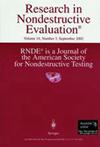Temperature Sensitivity Study of Eddy Current and Digital Gauge Probes for Oxide Measurement
IF 1.6
4区 材料科学
Q3 MATERIALS SCIENCE, CHARACTERIZATION & TESTING
引用次数: 2
Abstract
ABSTRACT Novel fuels are part of the nationwide effort to reduce the enrichment of Uranium for energy production. Fuel performance is determined by irradiating tfuel plates. The plate checker used in this experiment at Idaho National Lab (INL) performs nondestructive testing on fuel rod and plate geometries with two different types of sensors: eddy current and digital thickness gauges. The sensors measure oxide growth and sample thickness on research fuels, respectively. Sensor measurement accuracy is crucial because even microns of error is significant when determining the viability of an experimental fuel. One parameter known to affect the eddy current and digital gauge sensors is temperature. Since both sensor accuracies depend on the ambient temperature of the system, the plate checker has been characterized for these sensitivities. Additionally, the manufacturer of the digital gauge probes has noted a rather large coefficient of thermal expansion for their linear scale. In this work, the effect of temperature on the eddy current and digital gauge probes is evaluated, and thickness measurements are provided as empirical functions of temperature. Additionally, an experimental coefficient of thermal expansion for the probe material has been reported and compared with the manufacturer’s specifications.用于氧化测量的涡流和数字测量探头的温度灵敏度研究
新型燃料是减少用于能源生产的铀浓缩的全国性努力的一部分。燃料性能是通过辐照燃料板来确定的。在爱达荷国家实验室(INL)的实验中使用的板检查器使用两种不同类型的传感器:涡流和数字厚度计对燃料棒和板的几何形状进行无损检测。传感器分别测量研究燃料上的氧化物生长和样品厚度。传感器的测量精度是至关重要的,因为在确定实验燃料的可行性时,即使是微米的误差也很重要。已知影响涡流和数字仪表传感器的一个参数是温度。由于这两种传感器的精度都取决于系统的环境温度,因此板检查器具有这些灵敏度的特征。此外,数字测量探头的制造商已经注意到其线性刻度的热膨胀系数相当大。在这项工作中,评估了温度对涡流和数字测量探头的影响,并提供了厚度测量作为温度的经验函数。此外,还报道了探针材料的实验热膨胀系数,并与制造商的规格进行了比较。
本文章由计算机程序翻译,如有差异,请以英文原文为准。
求助全文
约1分钟内获得全文
求助全文
来源期刊

Research in Nondestructive Evaluation
工程技术-材料科学:表征与测试
CiteScore
2.30
自引率
0.00%
发文量
14
审稿时长
>12 weeks
期刊介绍:
Research in Nondestructive Evaluation® is the archival research journal of the American Society for Nondestructive Testing, Inc. RNDE® contains the results of original research in all areas of nondestructive evaluation (NDE). The journal covers experimental and theoretical investigations dealing with the scientific and engineering bases of NDE, its measurement and methodology, and a wide range of applications to materials and structures that relate to the entire life cycle, from manufacture to use and retirement.
Illustrative topics include advances in the underlying science of acoustic, thermal, electrical, magnetic, optical and ionizing radiation techniques and their applications to NDE problems. These problems include the nondestructive characterization of a wide variety of material properties and their degradation in service, nonintrusive sensors for monitoring manufacturing and materials processes, new techniques and combinations of techniques for detecting and characterizing hidden discontinuities and distributed damage in materials, standardization concepts and quantitative approaches for advanced NDE techniques, and long-term continuous monitoring of structures and assemblies. Of particular interest is research which elucidates how to evaluate the effects of imperfect material condition, as quantified by nondestructive measurement, on the functional performance.
 求助内容:
求助内容: 应助结果提醒方式:
应助结果提醒方式:


